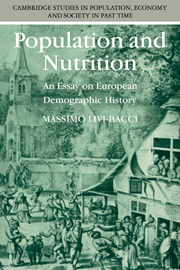Book contents
- Frontmatter
- Contents
- List of figures
- List of tables
- Preface
- 1 Demographic growth in Europe
- 2 Energy, nutrition and survival
- 3 Famine and want
- 4 The starving and the well-fed
- 5 Food and standard of living: hypotheses and controversies
- 6 Antagonism and adaptation
- Notes
- General index
- Cambridge Studies in Population, Economy and Society in Past Time
Preface
Published online by Cambridge University Press: 20 October 2009
- Frontmatter
- Contents
- List of figures
- List of tables
- Preface
- 1 Demographic growth in Europe
- 2 Energy, nutrition and survival
- 3 Famine and want
- 4 The starving and the well-fed
- 5 Food and standard of living: hypotheses and controversies
- 6 Antagonism and adaptation
- Notes
- General index
- Cambridge Studies in Population, Economy and Society in Past Time
Summary
Before the cycle of plagues broke out in the fourteenth century, the population of Europe fell short of the 100 million mark; four centuries later, at the start of the Industrial Revolution, it was close on 150 million and had topped 300 million by the end of the nineteenth century. The quantitative history of Europe is beset by catastrophes, slow progress and periods of unstable stagnation and its aspect would undoubtedly have been quite different had its demographic growth been faster, or slower, than it actually was.
Here we have the outline of a fascinating topic for investigation: what made Europe develop in this manner rather than another? What were the forces which determined its demographic growth? Obviously, the long-term development of a population is closely linked to that of the material resources available to it, but this observation fails to satisfy our curiosity for three basic reasons. The first is that demographic development and the development of resources are not independent phenomena; their various movements interact, reinforcing or attenuating one another in ways as varied as they are numerous. The second reason is that the correlation between the two phenomena is only approximate; were it perfect there would not be some societies that, given the same level of demographic expansion, grew poor while others grew rich, nor would there be populations that, given the same degree of economic expansion, grew a great deal while others grew only a little.
- Type
- Chapter
- Information
- Population and NutritionAn Essay on European Demographic History, pp. xi - xivPublisher: Cambridge University PressPrint publication year: 1991

